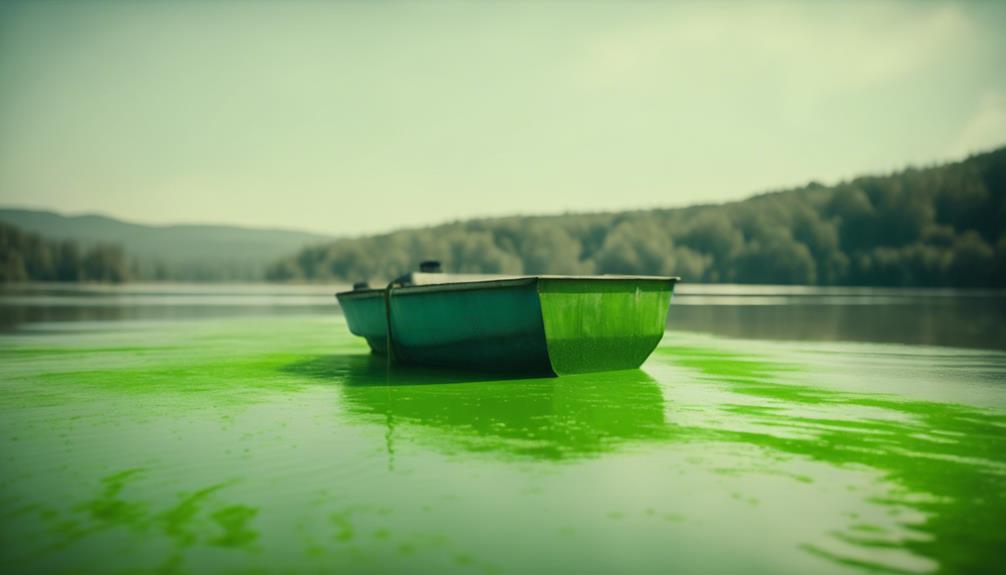When managing large water bodies, you need to control algae blooms effectively. You can start by implementing aeration, which increases oxygen levels and promotes beneficial bacteria. Ultrasonic methods can also be used to create a hostile environment for algae growth. Chemical control methods, such as algaecides, target specific algae species, but require careful application to avoid harming aquatic life. Biological augmentation introduces beneficial micro-organisms to maintain ecological balance. Finally, nutrient remediation solutions address the root cause of algae blooms by removing excess nutrients. By exploring these five essential methods, you'll be well on your way to mitigating the impacts of algae blooms.
Table of Contents
Key Takeaways
- Aeration systems can be installed in large water bodies to increase oxygen levels, reduce algae growth, and promote beneficial aerobic bacteria.
- Ultrasonic methods utilize high-frequency sound waves to create a hostile environment for algae growth, causing cells to rupture and die.
- Chemical control methods, such as algaecides, can be used to target specific algae species and manage blooms, but require careful consideration and application.
- Biological augmentation introduces beneficial micro-organisms and enzymes to ponds, boosting natural populations and reducing nutrient accumulation to prevent algae blooms.
- Nutrient remediation solutions, such as lanthanum-modified clay and alum, address the root cause of algae blooms by removing excess phosphorus and other nutrients from the waterbody.
Aeration for Algae Control
When it comes to controlling algae growth, you can consider aeration as a non-chemical method that effectively increases oxygen levels in the water, thereby reducing the conditions that favor algae growth and promoting the growth of beneficial aerobic bacteria.
In large water bodies, aeration systems can be installed to mix the water, breaking down thermoclines and reducing the stratification that can contribute to algae blooms.
This approach not only improves oxygen concentrations but also enhances water circulation, making it more difficult for algae to thrive.
By increasing dissolved oxygen levels, aeration reduces the risk of eutrophication, a process that depletes oxygen and harms aquatic life.
Additionally, aeration promotes a healthy aquatic ecosystem by supporting the growth of beneficial aerobic bacteria, which outcompete algae for resources.
Ultrasonic Algae Removal Methods
You can harness the power of ultrasonic algae removal methods, which utilize high-frequency sound waves to create a hostile environment for algae growth, causing cells to rupture and ultimately die. This non-toxic and environmentally friendly method is effective against a wide range of algae species, including cyanobacteria, green algae, and diatoms.
| Method | Effectiveness | Benefits |
|---|---|---|
| Ultrasonic Algae Removal | Reduces algae biomass by up to 90% | Improves water clarity and quality, prevents algae growth |
| Aeration for Algae Control | Increases dissolved oxygen concentrations | Supports sustainable algae management, improves water quality |
| Combining Methods | Enhances effectiveness against multiple algae species | Provides ideal results, improves water quality |
Chemical Control of Algae Blooms

While ultrasonic methods offer a non-toxic approach to algae control, chemical control methods, such as algaecides, can be used to target specific algae species and effectively manage blooms, but require careful consideration and application to avoid harming other aquatic life.
You'll need to choose the right algaecide for the job, as different types of algae respond to different treatments. Copper-based algaecides like copper sulfate are effective against certain types of algae, but they can accumulate in sediment and have long-term environmental impacts.
Peroxygen compounds like hydrogen peroxide release oxygen upon decomposition, controlling algae growth, but can also harm beneficial aquatic organisms if used in excess.
Quaternary ammonium compounds (quats) disrupt algal cell walls, leading to cell lysis and death, but require proper use to avoid negative impacts on aquatic life and human health.
Biological Augmentation for Balance
Biological augmentation introduces beneficial micro-organisms and enzymes to ponds, boosting natural populations and reducing the accumulation of nutrients and organic sludge that fuel algae growth.
By dosing these micro-organisms, you'll maintain healthy water ecosystems and reduce the accumulation of nutrients and organic sludge, promoting healthy water quality.
This natural and effective method balances nutrient levels in ponds, removing the primary food source for algae blooms and promoting ecological balance.
Beneficial bacteria break down organic matter and consume excess nutrients, creating a balanced ecosystem that discourages excessive algae growth.
Oxygen helps break down organic matter, and the internal phosphorus cycle is maintained, guaranteeing the entire water body remains healthy.
Surface water circulation causes less stagnation, reducing environmental damage.
By using biological augmentation in conjunction with other control methods, such as aeration systems, you'll create a thorough approach to preventing algae blooms in large water bodies.
This holistic approach certifies a thriving ecosystem, free from the negative impacts of algae growth.
Nutrient Remediation Solutions

Effective nutrient remediation solutions are essential to preventing algae blooms, as they address the root cause of the problem by removing excess phosphorus and other nutrients from the waterbody.
You'll want to weigh solutions that can permanently remove phosphorus, such as lanthanum-modified clay, which locks it away in the pond's bottom sediment. Alum is another effective option, forming a fluffy precipitate that traps phosphorus and other nutrients, making them unavailable for algae growth.
This not only improves water clarity but also prevents eutrophication. Biological augmentation can also aid in maintaining healthy water ecosystems by utilizing naturally occurring microbes and enzymes that break down organic matter and consume excess nutrients.
Regular monitoring of key water quality parameters, such as phosphorus levels, is vital to identifying nutrient imbalances and implementing effective nutrient remediation solutions.
Frequently Asked Questions
What Is the Best Method to Control Algae?
You'll find that combining algae monitoring systems with water purification techniques helps maintain ecological balance in aquatic ecosystems, reducing harmful blooms and toxic substances, while effective cyanobacteria management guarantees a thriving aquatic life.
How to Control Algae in a Large Pond?
To control algae in your large pond, you'll need to tackle the root causes: poor water circulation, excess nutrients, and inadequate shoreline management.
Which Is Widely Used for Algae Control?
You'll find that artificial circulation is widely used for algae control, as it helps prevent toxic blooms, algal mats, and fish kills, while reducing water discoloration and sedimentation process issues, often triggered by fertilizer runoff.
What Are the Methods of Algae Removal?
You'll be surprised to know that 1 square meter of algae can produce up to 100 liters of oxygen daily! To remove algae, you can use methods like algae skimmers, manual removal, water circulation, algae barriers, ultrasound technology, aeration systems, biological controls, chemical treatments, algae eaters, and oxygenerators.
Conclusion
As you gaze out at the serene waters, remember that beneath the surface, a delicate balance is at play.
Implementing these 5 essential algae control methods is vital to preserving the ecosystem's harmony.
Aeration, ultrasonic removal, chemical control, biological augmentation, and nutrient remediation are the methods to be orchestrated.
Like a conductor leading an orchestra, you must carefully orchestrate these methods to create a symphony of balance, ensuring the water body's beauty and health are preserved for generations to come.

